For those who weren't lucky enough to visit and see it for them selves, VISIT! We all need some Irish luck in our lives!
Ireland is exceptionally beautiful and green, as are the gemstones, that is why it's known as The Emerald Isle, however, It was thanks to a remarkable Irishman called William Drennan who referred to Ireland as The Emerald in one of his poems When Erin First Rose.
Alas! for poor Erin that some are still seen,
Who would dye the grass red from their hatred to green;
Yet, oh! when you're up, and they're down, let them live,
Then yield them that mercy which they would not give.
Arm of Erin, be strong! but be gentle as brave;
And uplifted to strike, be still ready to save;
Let no feeling of vengeance presume to defile
The cause of, or men of, the Emerald Isle.
The Republic of Ireland occupies most of the island of Ireland, off the coast of England and Wales. Its eastern capital, Dublin is the birthplace of amazing writers like Oscar Wilde and Samuel Beckett and of course home of the Guinness Beer.
The culture and history will amaze you, the struggle Irish people had to go through is unreal!
For English speakers, you will find getting around much easier, however Ireland still has a native language called Irish Gaelic, you're unlikely to ever hear it in conversation unless you travel to a remote village on the western coast of the island.
Before I came to Ireland to do my degree, I thought everyone was going to be talking in Irish, I was so excited about learning a new language. well, no.
The people of Ireland, are extremely and incredibly friendly, from the second I reached the airport for the first time I fell in love with the country. As a 18 year old, scared and confused I came,as soon as I met the Irish, It felt like I was home!
I think the people of Ireland are the most stereotyped people of any country! Before coming here I expected drunken ginger leprechauns with pots of gold sliding down rainbows. I was disappointed.
Here comes my favorite part of the post. FOOD and MUSIC!
The indigenous music of the island is referred to as Irish traditional music. It has remained vibrant through the 20th, and into the 21st century, despite globalizing cultural forces. In spite of emigration and a well-developed connection to music influences from Britain and the United States, Irish music has kept many of its traditional aspects and has itself influenced many forms of music, such as country and roots music in the USA, which in turn have had some influence on modern rock music. It has occasionally been fused with rock and roll, punk and rock and other genres. Some of these fusion artists have attained mainstream success, at home and abroad.
Here is the amazing traditional dance called the Riverdance
And now "drumroll" .. FOOD *Sparkling eyes*
Irish cuisine evolved from centuries of social and political change and mixing between the different cultures on the island, predominantly English and Irish. The cuisine takes its influence from the crops grown and animals farmed in its temperate climate.
However, the development of Irish food was affected negativly by the English conquest in the early 17th century because this forced the impoverishment of the mass through land dispossession and the organisation of Ireland's food economy to provide supplies to England and its armed forces. Consequently, The "Potahto" became almost the only food of the poor (the vast majority of the population) and as a result is often now closely associated with Ireland.
Unfortunately many elements of the Irish Cuisine were lost or abandoned during this time, but are now being revived. Represntive modern Irish dishes include Irish Stew, Bacon and Cabbage, Boxty and Colcannon.
 |
| Boxty |
 |
| Irish beef stew |
Yummy Yummy!
Well, by now you should have already booked your ticket to the Emerald Isle. A beautiful country with beautiful people, music and food. What else do you want!



































